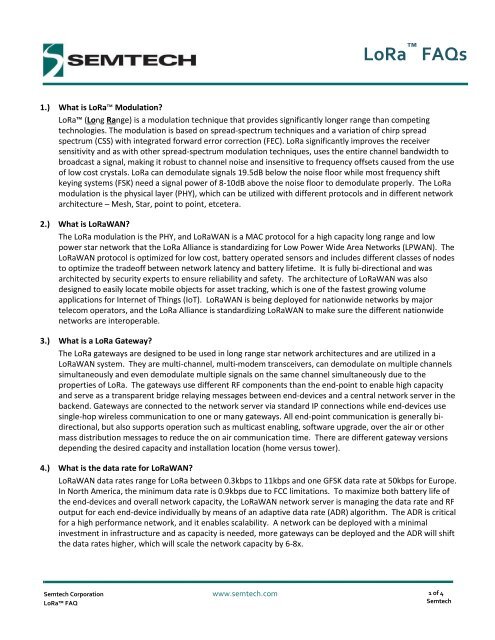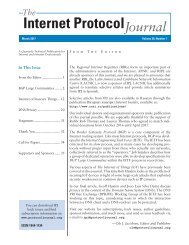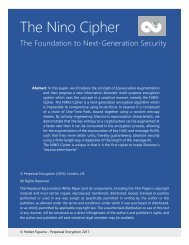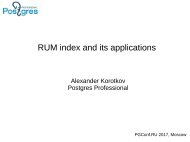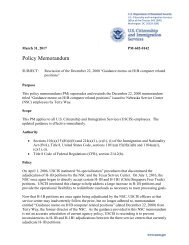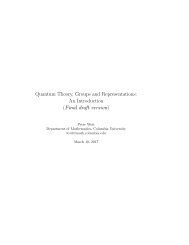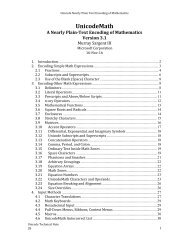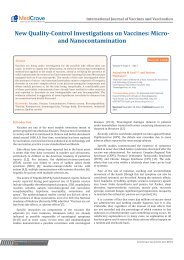LoRa FAQs bidirectional
1MpXTLv
1MpXTLv
Create successful ePaper yourself
Turn your PDF publications into a flip-book with our unique Google optimized e-Paper software.
<strong>LoRa</strong> <strong>FAQs</strong><br />
1.) What is <strong>LoRa</strong> Modulation?<br />
<strong>LoRa</strong> (Long Range) is a modulation technique that provides significantly longer range than competing<br />
technologies. The modulation is based on spread-spectrum techniques and a variation of chirp spread<br />
spectrum (CSS) with integrated forward error correction (FEC). <strong>LoRa</strong> significantly improves the receiver<br />
sensitivity and as with other spread‐spectrum modulation techniques, uses the entire channel bandwidth to<br />
broadcast a signal, making it robust to channel noise and insensitive to frequency offsets caused from the use<br />
of low cost crystals. <strong>LoRa</strong> can demodulate signals 19.5dB below the noise floor while most frequency shift<br />
keying systems (FSK) need a signal power of 8-10dB above the noise floor to demodulate properly. The <strong>LoRa</strong><br />
modulation is the physical layer (PHY), which can be utilized with different protocols and in different network<br />
architecture – Mesh, Star, point to point, etcetera.<br />
2.) What is <strong>LoRa</strong>WAN?<br />
The <strong>LoRa</strong> modulation is the PHY, and <strong>LoRa</strong>WAN is a MAC protocol for a high capacity long range and low<br />
power star network that the <strong>LoRa</strong> Alliance is standardizing for Low Power Wide Area Networks (LPWAN). The<br />
<strong>LoRa</strong>WAN protocol is optimized for low cost, battery operated sensors and includes different classes of nodes<br />
to optimize the tradeoff between network latency and battery lifetime. It is fully bi-directional and was<br />
architected by security experts to ensure reliability and safety. The architecture of <strong>LoRa</strong>WAN was also<br />
designed to easily locate mobile objects for asset tracking, which is one of the fastest growing volume<br />
applications for Internet of Things (IoT). <strong>LoRa</strong>WAN is being deployed for nationwide networks by major<br />
telecom operators, and the <strong>LoRa</strong> Alliance is standardizing <strong>LoRa</strong>WAN to make sure the different nationwide<br />
networks are interoperable.<br />
3.) What is a <strong>LoRa</strong> Gateway?<br />
The <strong>LoRa</strong> gateways are designed to be used in long range star network architectures and are utilized in a<br />
<strong>LoRa</strong>WAN system. They are multi-channel, multi-modem transceivers, can demodulate on multiple channels<br />
simultaneously and even demodulate multiple signals on the same channel simultaneously due to the<br />
properties of <strong>LoRa</strong>. The gateways use different RF components than the end-point to enable high capacity<br />
and serve as a transparent bridge relaying messages between end-devices and a central network server in the<br />
backend. Gateways are connected to the network server via standard IP connections while end-devices use<br />
single-hop wireless communication to one or many gateways. All end-point communication is generally <strong>bidirectional</strong>,<br />
but also supports operation such as multicast enabling, software upgrade, over the air or other<br />
mass distribution messages to reduce the on air communication time. There are different gateway versions<br />
depending the desired capacity and installation location (home versus tower).<br />
4.) What is the data rate for <strong>LoRa</strong>WAN?<br />
<strong>LoRa</strong>WAN data rates range for <strong>LoRa</strong> between 0.3kbps to 11kbps and one GFSK data rate at 50kbps for Europe.<br />
In North America, the minimum data rate is 0.9kbps due to FCC limitations. To maximize both battery life of<br />
the end-devices and overall network capacity, the <strong>LoRa</strong>WAN network server is managing the data rate and RF<br />
output for each end-device individually by means of an adaptive data rate (ADR) algorithm. The ADR is critical<br />
for a high performance network, and it enables scalability. A network can be deployed with a minimal<br />
investment in infrastructure and as capacity is needed, more gateways can be deployed and the ADR will shift<br />
the data rates higher, which will scale the network capacity by 6-8x.<br />
Semtech Corporation<br />
<strong>LoRa</strong> FAQ<br />
www.semtech.com 1 of 4<br />
Semtech
5.) What is a <strong>LoRa</strong> Concentrator?<br />
The term gateway and concentrator are both used, but they are equivalent components in a <strong>LoRa</strong> system. In<br />
other industries, the definition of gateway and concentrator imply different components.<br />
6.) How well does <strong>LoRa</strong> handle Interference?<br />
The <strong>LoRa</strong> modem is capable of co-channel GMSK rejection of up to 19.5 dB or stated differently, it can receive<br />
signals 19.5dB below an interfering signal or the noise floor. This immunity to interference permits the simple<br />
coexistence of <strong>LoRa</strong> modulated systems either in bands of heavy spectral usage or in hybrid communication<br />
networks that use <strong>LoRa</strong> to extend range when legacy modulation schemes fail.<br />
7.) What is the data rate for <strong>LoRa</strong>?<br />
<strong>LoRa</strong>WAN defines a specific set of data rates, but the end chip or PHY is capable of more options. The SX1272<br />
supports data rates from 0.3 to 37.5kbps and the SX1276 0.018 to 37.5kbps.<br />
8.) What is a <strong>LoRa</strong> End Node or Point?<br />
The <strong>LoRa</strong> endpoints are the elements of the <strong>LoRa</strong> network where the sensing or control is undertaken. They<br />
are remotely located and battery operated. These endpoints can be setup to communicate with a <strong>LoRa</strong><br />
Gateway (Concentrator or Base Station) using the <strong>LoRa</strong>WAN network protocol.<br />
9.) What is Adaptive Data Rate (ADR)?<br />
ADR is a method where the actual data rate is adjusted to ensure reliable packet delivery, optimal network<br />
performance, and scale for capacity. For example, nodes close to the gateway will use a higher data rate<br />
(shorter time on air) and a lower output power. Only Nodes that are at the very edge of the link budget will<br />
use the lowest data rate and highest output power. The ADR method can accommodate changes in the<br />
network infrastructure and support varying path loss. To maximize both battery life of end-devices and<br />
overall network capacity, the <strong>LoRa</strong> network infrastructure manages the data rate and RF output for each enddevice<br />
individually by implementing ADR.<br />
10.) For the <strong>LoRa</strong> devices, what is the actual Tx power that can be achieved on the antenna?<br />
At the chip pin, the output power is +20dBm and at the antenna after matching/filtering loss, the power is<br />
+19dBm +/-0.5dB. Different regions have different regulations for max output power, and the <strong>LoRa</strong>WAN<br />
specification defines different output power for the different regions to maximize the link budget.<br />
11.) What is the price of a <strong>LoRa</strong> solution?<br />
With a <strong>LoRa</strong> device (ex: SX1272 or SX1276), a lower cost crystal can be used. In narrow band technology, an<br />
expensive temperature controlled crystal oscillator is needed to minimize frequency drift during RX/TX. A<br />
typical bill of materials cost for a complete end-node is $2-$5 depending on volume and features. A long<br />
transmit range means simpler network infrastructure and lower cost of deployment as no repeaters are<br />
necessary. Lower power consumption means use lower cost batteries and network maintenance.<br />
12.) What is the process of the <strong>LoRa</strong> Channel Activity Detection (CAD) mode?<br />
Instead of using a Received Signal Strength Indicator (RSSI) method to identify if a signal is present, the CAD is<br />
used to detect the presence of a <strong>LoRa</strong> signal. It has the capability to differentiate between noise and a desired<br />
<strong>LoRa</strong> signal. The CAD process requires two symbols, and if the CAD is detected, the CAD_Detected interrupt<br />
will be asserted and the device will stay in RX mode to receive the data payload.<br />
Semtech Corporation<br />
<strong>LoRa</strong> FAQ<br />
www.semtech.com 2 of 4<br />
Semtech
13.) Why is the output power of my <strong>LoRa</strong> device or Module not able to achieve 20dBm?<br />
The +20dBm specification is for the output power at the pin of the chip. The band-pass filter and RF switch<br />
have insertion loss characteristics as in any RF system. Achieving +19dBm at the antenna is typical<br />
performance after matching and filtering.<br />
14.) Is it OK to change the mode between FSK and <strong>LoRa</strong> modulation frequently?<br />
Yes, it is no problem. The <strong>LoRa</strong> device can be switched from FSK to <strong>LoRa</strong> (and vice versa) via simple SPI register<br />
write. This has no effect on the performance or reliability of the device. A <strong>LoRa</strong> device can be configured and<br />
reconfigured to any of the parameters as specified in the datasheets.<br />
15.) How to troubleshoot the output power if it is not able to achieve +20dBm?<br />
1.) Please make sure that you connect the right pin (PA_Boost) set for 20dBm output.<br />
There are two output ports for each band. One is high power port called PA_boost, another is high<br />
efficiency port called RFO.<br />
2.) Then, check the configuration in SW. Three registers should be configured correctly: RegPaConfig, RegOcp<br />
and RegPaDac. This means that you should select the right pin for proper output in SW, then set the right<br />
value refer to power level you need.<br />
3.) Confirm they match per the Semtech reference design to make a good layout. This is important to achieve<br />
the maximum output power possible<br />
16.) How can I implement a mass production test for a <strong>LoRa</strong> system?<br />
Three parameters are important to test in mass production: frequency tolerance, output power, and<br />
sensitivity. The frequency and output power are easy to test with a spectrum analyzer. If your signal<br />
generator cannot generate a <strong>LoRa</strong> signal, testing the sensitivity with FSK mode is strongly suggested. There is<br />
only one RF chain in the chip, and the FSK and <strong>LoRa</strong> demodulation is done in the digital domain. The RF path<br />
could potentially be misassembled (ex: dry joint on a DC-cut) so this is important to verify. The digital portion<br />
of the chip where the <strong>LoRa</strong> and FSK modulation is done is isolated from the effects of assembly so testing FSK<br />
sensitivity is sufficient for verifying the production test performance. The digital and <strong>LoRa</strong> modulation are<br />
tested extensively in the chip production test.<br />
17.) How to choose a proper crystal for a <strong>LoRa</strong> device?<br />
Normally, a +/-10ppm XTAL is good enough for most designs with a bandwidth of 62.5kHz or higher. For<br />
bandwidth (BW) less than 62.5kHz, a TCXO is strongly suggested. For more details about the specification of<br />
the crystal, please refer to the datasheet and <strong>LoRa</strong> Modem Calculator tool and application note<br />
AN1200.14_XO_Guidance_<strong>LoRa</strong>_Modulation_STD”.<br />
18.) For a <strong>LoRa</strong> wide band signal, how can you measure the frequency accuracy in <strong>LoRa</strong> mode?<br />
If it is just for measurement, you can use the Frequency synthesis TX (FSTX) mode as listed in the <strong>LoRa</strong> register<br />
table to generate a CW tone based on the <strong>LoRa</strong> configuration.<br />
19.) What is the relationship between BW, Symbol Rate (Rs) and Data Rate (DR)?<br />
In theory, Rs=BW/(2^SF), DR= SF*( BW/2^SF)*CR, but we suggest you use the Semtech <strong>LoRa</strong> Modem<br />
Calculator to evaluate the data rate and time on air for different configuration options.<br />
Semtech Corporation<br />
<strong>LoRa</strong> FAQ<br />
www.semtech.com 3 of 4<br />
Semtech
20.) How do you choose the <strong>LoRa</strong> BW, Spreading factor (SF) and Coding Rate (CR)?<br />
<strong>LoRa</strong>WAN uses primarily the 125kHz BW setting, but other proprietary protocols can utilize other BW settings.<br />
Changing the BW, SF, and CR changes the link budget and time on air, which results in a battery lifetime versus<br />
range tradeoff. Please use the <strong>LoRa</strong> Modem Calculator to evaluate the tradeoffs.<br />
21.) What are the steps to troubleshoot when two SX127x modules from different manufacturers are not<br />
able to communicate with each other?<br />
First of all, check the frequency offset caused by the crystal between the two devices. The BW, center<br />
frequency, and data rate are all derived from the crystal frequency. Second, check the software/firmware<br />
settings on both sides for frequency, bandwidth, spreading factor, coding rate and packet structure to ensure<br />
they are the same.<br />
22.) How can it be possible to receive a wrong packet when the cyclic redundancy check (CRC) is enabled<br />
in <strong>LoRa</strong> mode?<br />
In <strong>LoRa</strong> mode, even if the CRC is wrong the payload will be filled into the FIFO. Bit PayloadCrcError must be<br />
checked before fetching the payload to know its integrity. In Explicit Header mode, there is a small probability<br />
that a false detection creates a “ghost” packet. Either the false header has CrcOn bit turned on, and then the<br />
payload will be wrong, and the modem will flag it as a PayloadCrcError condition, so packet can easily be<br />
filtered out. Or the false header has CrcOn disabled, in which case the mode will consider the packet as a good<br />
one. These infrequent bad packet will have a random length (extracted from the false header info), and can be<br />
easily filtered by the host, for instance by seeing that their size is unexpected.<br />
23.) Can I send or receive an unlimited length payload packet with a <strong>LoRa</strong> device?<br />
No, the maximum packet length is 256 bytes in <strong>LoRa</strong> mode.<br />
24.) How can you use the DIOx pins in <strong>LoRa</strong> mode? Should all DIOx pins be connected to the MCU?<br />
When you start your design, check the DIO Mapping in both the <strong>LoRa</strong> mode and FSK mode. You can find the<br />
DIO Mapping information in SX127x <strong>LoRa</strong> datasheets. The DIOs do not function as normal (typical) MCU<br />
GPIOs. There are some special interrupt signals (or clock outputs) to indicate the event or status of the<br />
chipset, which then make your FW design easier to implement. In theory, you could connect no DIOs and then<br />
poll the related register to know the status result. However, we suggest that you connect the DIO as much as<br />
possible for external interrupt functionality which saves on the resource loading of the MCU and permits a<br />
very low-power operation mode (the MCU can sleep while packet it Tx’ed or Rx’ed).<br />
25.) Why are there two RSSI registers in <strong>LoRa</strong> mode? What is the difference?<br />
The RegPktRssiValue and RegRssiValue are both useful in <strong>LoRa</strong> mode. RegPktRssiValue refers to the packet<br />
RSSI level, and the RegRssiValue is similar to the RSSI that can be found in (non <strong>LoRa</strong>) FSK mode.<br />
As you know, <strong>LoRa</strong> can demodulate the packet below the noise floor (PktRssi result) then CurrentRssi will then<br />
be equal to or more than the noise floor. For more details about how to calculate these two RSSI Values,<br />
please refer to the Semtech API or latest <strong>LoRa</strong> datasheets.<br />
Semtech Corporation<br />
<strong>LoRa</strong> FAQ<br />
www.semtech.com 4 of 4<br />
Semtech
26.) How can you calculate the actually bit rate and time on air for a <strong>LoRa</strong> system?<br />
Follow the steps (i – V) listed below:<br />
This is easy to calculate by using <strong>LoRa</strong> calculator, which can be downloaded on Semtech website (link below).<br />
http://www.semtech.com/apps/filedown/down.php?file=SX1272<strong>LoRa</strong>CalculatorSetup1%271.zip<br />
27.) Can the payload length of a <strong>LoRa</strong> mode configuration be set to 256bytes with any data-rate?<br />
The SX127x <strong>LoRa</strong> device has a FIFO of 256bytes in <strong>LoRa</strong> mode. In theory, all the 256Bytes can be used for TX or<br />
RX. However, with a low data-rate configuration, the time on air with a 256byte payload will be very long<br />
(several seconds or even longer), which is not good for resisting fading and high interference<br />
environments. This is not a robust configuration in most environments so it is suggested that if a long payload<br />
is desired with a low data-rate then the packet be split into a few shorter packets.<br />
28.) Is <strong>LoRa</strong> a mesh network, point to point, or a star network?<br />
The <strong>LoRa</strong> modulation itself is a PHY that can be used in all network topologies. A mesh network extends the<br />
range of the network but comes at the cost of reduced network capacity, synchronization overhead, and<br />
reduced battery lifetime due to synchronization and hops. With the increased link budget and range capability<br />
of <strong>LoRa</strong>, there is no need for a mesh network architecture to extend the range so a star architecture was<br />
chosen for <strong>LoRa</strong>WAN to optimize the network capacity, battery lifetime, and installation ease.<br />
29.) Is <strong>LoRa</strong> IPv6 or 6LoWPAN enabled?<br />
Yes, <strong>LoRa</strong> is IPv6 and 6LoWPAN compatible. Actility (a <strong>LoRa</strong> partner) and other partners enabled 6LoWPAN on<br />
top of <strong>LoRa</strong>WAN.<br />
30.) What is the capacity of <strong>LoRa</strong> gateway? How many nodes can be connected to a single gateway?<br />
Capacity is, first and foremost, a consequence of the number of packets that can be received in a given time. A<br />
single SX1301 with 8 channels can receive approximately 1.5 million packets per day using <strong>LoRa</strong>WAN protocol.<br />
So, if your application sends one packet per hour, then a single SX1301 gateway can handle about 62,500 enddevices.<br />
Semtech Corporation<br />
<strong>LoRa</strong> FAQ<br />
www.semtech.com 5 of 4<br />
Semtech


